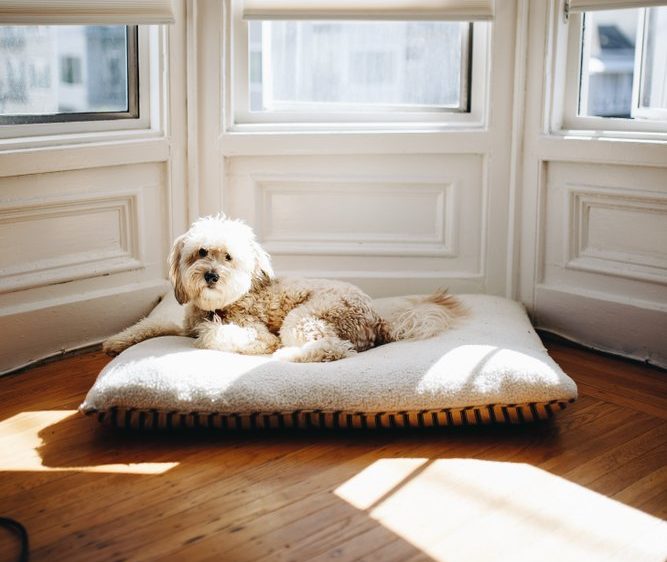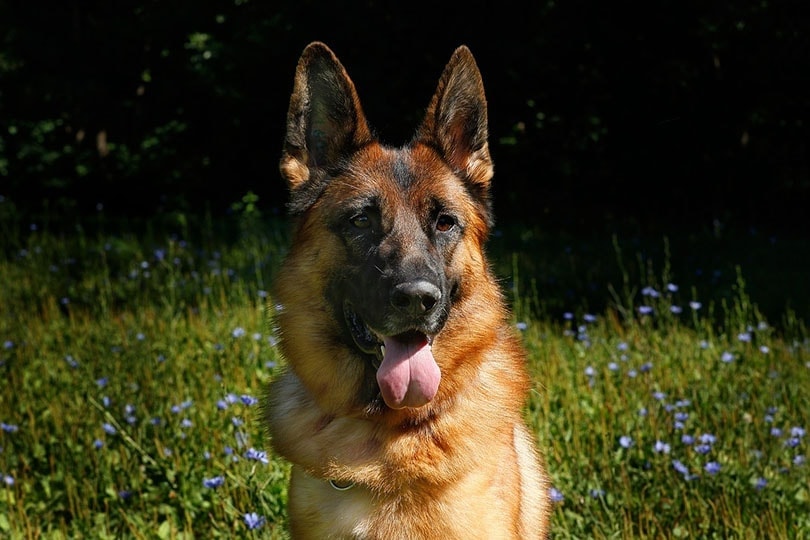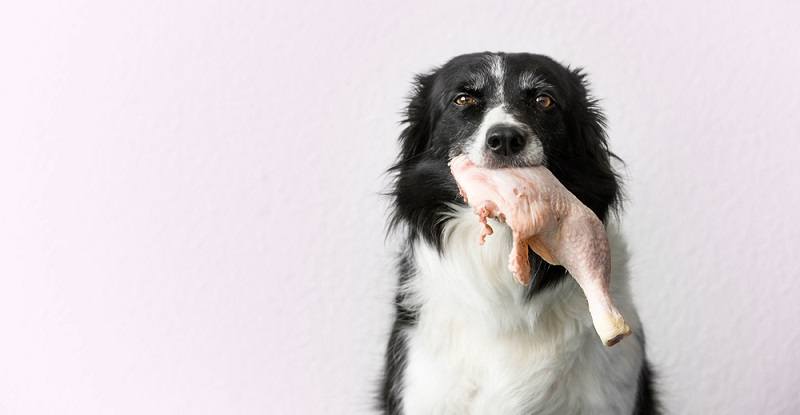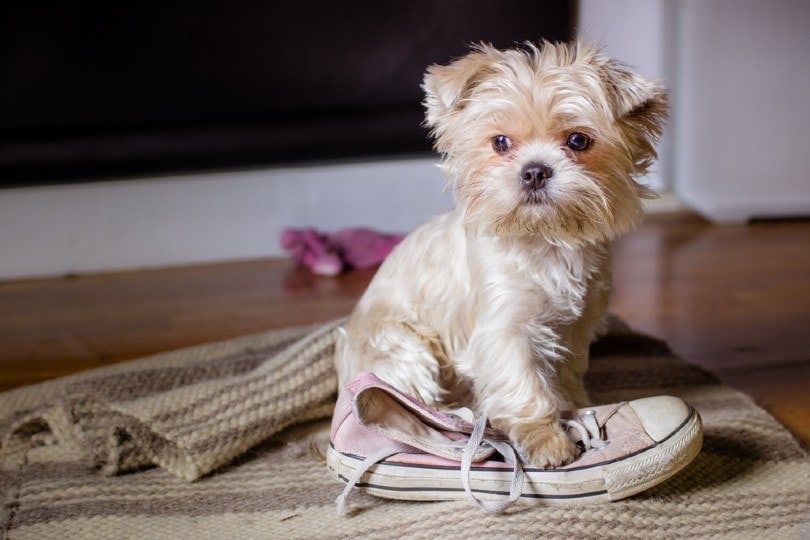Height:
12-20 inches
Weight:
20-60 pounds
Lifespan:
12-15 years
Colors:
Cream, silver, red, brown, black, champagne, honey, mahogany
Suitable for:
Active families, experienced owners
Temperament:
Intelligent, extroverted, stubborn, strong prey drive
It seems like every breeder on the planet is trying to cross-breed Poodles with other dogs these days, and for good reason: Poodles are incredibly intelligent, don’t shed much, and are extremely loyal.
One of the most popular Poodle mixes is the Whoodle, which is a Poodle mixed with a Wheaten Terrier. The result looks more like a teddy bear than a dog — but we’ve never heard anyone complain about that.
They come in at least three different sizes and have just as many alternative names (you may also hear them described as Sweatenpoos, Wheatendoodles, Wheatenpoos, or Wheatiepoos). Regardless of how big they are or what you call them, though, these dogs are extremely intelligent and equally energetic.
Whoodle Puppies — Before You Buy…
Poodles and Wheaten Terriers are both notoriously smart, so when you combine the two, you get a dog that’s no slouch upstairs. This is both a blessing and a curse, as they can quickly pick up on commands during training — but only if they want to.
The Wheaten Terrier Poodle Mix’s stubborn streak, combined with their high energy levels, make them challenging pets for first-time owners, so they’re probably best suited for people who already have experience raising and training dogs. They can be great family pets, but you’ll need to continually work with them to ensure that happens.
These dogs make wonderfully unique and spirited companions, but if you feel like you’re not familiar enough with the breed to bring one home, the guide below should walk you through everything you need to know.
What’s the Price of Whoodle Puppies?
Some people care very much about the bloodlines of their dogs — and many of those people own Poodles.
As a result, the price of Whoodle puppies can vary wildly, with some of them getting quite expensive. The price usually depends on the heritage of the Poodle half of the breed, but some Wheaten Terriers can have notable backgrounds as well.
Generally speaking, you can expect to pay anywhere from $1,200-$5,500 for a Whoodle puppy. You can find great dogs on the lower end of that spectrum, provided you don’t care who their grandparents were.
That said, you should always be suspicious when a breeder offers a deal that’s too good to be true. Many backyard breeders stay in business by undercutting the competition, so try to check out their facilities (or at least check their references) before buying a puppy.
We’re huge advocates of adopting from shelters, but if your heart is set on a Whoodle, you’ll likely need to go through a breeder to get one.
Three Little-Known Facts About Whoodles
1. No one knows when or where the breed started.
We don’t know when or where the first Whoodle came from, but once the designed dog breed trend started in the 1970s, it was only a matter of time before they came along.
The first designer breed was the Labradoodle, which is a combination of a Labrador and Poodle. These dogs were so popular that breeders were soon mixing Poodles with every breed under the sun, Wheaten Terriers (eventually) included.
The Whoodle began rising to prominence in the early 2000s, so it’s likely they were first bred a short time before that.
2. They come in three sizes.
Poodles come in three sizes: standard, miniature, and toy. As a result, the size of your Whoodle will depend on the size of the Poodle used to create it.
That’s why you’ll see such a wide disparity in heights and weights with these dogs. Some of them are on the larger side of medium, while others are quite small indeed.
Whoodles of all sizes tend to share similar personality traits, though.
3. Their coats come in a wide assortment of colors.
There is no “standard” color for Whoodles, as you can find them in black, white, tan, red, or even spotted.
The most common coloring, however, is a creamy tan or wheat color. This is how most Wheaten Terriers look, and it tends to trickle down to their designer offspring as well.
Temperament and Intelligence of the Whoodle
Both Poodles and Wheaten Terriers are smart dogs, so it’s no surprise that Whoodles would be at the head of the class in terms of intelligence as well.
In fact, these dogs are so smart, they have little tolerance for foolishness from their owners. This means that while they can pick up training cues quickly, they’ll also soon discover if you’re not confident with issuing commands. These dogs can absolutely walk all over you if they sense that they can get away with it.
That being said, they’re not malicious; instead, they’ll just do what they feel like. This can lead to behavior problems down the line, especially considering how strong the Wheaten Terrier’s prey drive can be.
They’re usually affectionate animals, though, and love to demand attention from their owners. They’re fairly outgoing as well, which makes them great for finding you a date at the park, but not so great for protecting your PlayStation.
Are These Dogs Good for Families?
These dogs are typically good with families, as they’re not prone to aggression and love to cuddle.
However, the aforementioned prey drive can cause issues if you have small children in the house. You don’t need to necessarily worry about safety from these dogs, but they will try to herd your toddlers.
These dogs have high energy levels as well, so having a large family can help defray the demands they’ll make on your time and energy. Someone has to walk and train them every day, and if there’s no one else home, the job will fall to you.
Does This Breed Get Along With Other Pets?
Let’s talk about the prey drive.
These dogs like to chase things. It’s what they do, and if your dog has that instinct, there’s nothing you can do to turn it off.
As noted, they’re usually not aggressive, so you don’t have to worry about them killing what they catch, but that might not make your cat any happier about being pinned to the ground for the fifth time this week.
They have a strong pack mentality, though, so they should be welcoming of any other dogs. That doesn’t mean you shouldn’t socialize them as puppies, though.
Things to Know When Owning a Whoodle
There’s more to owning a Whoodle than just coming up with enough scratch to pay the breeder. These dogs can be challenging, especially for first-time owners, so it behooves you to learn as much as you can about them before you bring one home.
Food and Diet Requirements
The amount these dogs eat will depend in large part on which size you get. Standard Whoodles can eat a fair bit of kibble, while the toy and miniature varieties are much more budget-friendly to feed.
We recommend feeding them a high-protein kibble without animal by-products or cheap filler grains like wheat and corn. This should be enough to keep them lean and healthy well into their senior years.
These dogs can often experience joint problems later in life (especially the bigger pups), so we recommend finding a food with glucosamine and chondroitin in it or giving your dog a supplement.
You also need to go easy on the treats and scraps — and given how smart these dogs are, that can mean taking extraordinary measures to hide food. Don’t assume that they won’t figure out a way to get on the counter or pry open those plastic containers because these dogs are furry little geniuses.
Exercise
Whoodles have a great deal of energy, so expect to spend a great deal of time trying to run them ragged. They need at least an hour of moderate physical activity per day.
What these dogs crave, however, is mental stimulation. You need to tax their brains, and puzzle toys, obedience classes, and agility training are all excellent ways to do this. If you keep their minds occupied, you can skimp a little bit on fatiguing their bodies.
Don’t take it too far, though. As mentioned, these dogs are prone to joint problems, so it’s essential to keep them at a healthy weight. Not overfeeding them is the most important thing, but ensuring that they burn off calories is a close second.
At the very least, take them for a long walk every day. Keeping a brisk pace is important, but let them stop to sniff around too, as that works their mind (and their noses, we assume).

Training
Regular training is absolutely essential with these dogs. It’s equally essential to have a trainer who knows what they’re doing, so if that’s not you, find someone who can help.
Since they’re incredibly intelligent, they can figure out what you want them to do in no time. If you have a firm hand, that can make training sessions a breeze, but if they learn that you’re a pushover, you might have a devil of a time getting them to do what you tell them.
That being said, these dogs respond much better to positive reinforcement than they do criticism, so never scold or punish them. They’re surprisingly sensitive, and if you hurt their feelings, they’ll make the rest of the training session a nightmare.
Socialization is also incredibly important for preventing future behavioral problems. Try to introduce your Whoodle to as many people, dogs, and other animals as possible, and reward them for being on their best behavior.
Grooming ✂️
Many Whoodles are hypoallergenic and won’t shed at all, thanks to their Poodle genetics. However, that’s not guaranteed, so be sure to double-check with your breeder before you buy if that’s a dealbreaker for you.
Regardless, you’ll need to brush your Whoodle at least once a week or daily, if they have long, shaggy hair. They also need periodic haircuts, so find a groomer you trust or learn to do it yourself.
Their coats tend to attract dirt and mud, so if you let your dog wander around outside, there’s a good chance that they’ll come back filthy. Expect to bathe them every time they’re visibly dirty, but beyond that, they should be fine with being washed every other month or so.
You still need to trim their nails and clean their ears, same as any other dog.
Health and Conditions
Whoodles are generally healthy dogs, as mixed breeds are usually healthier than purebreds (and neither Poodles and Wheaten Terriers are prone to many serious health issues). That being said, there are a few things you should be aware of that might afflict them at some point in their lives:
- Thyroid conditions
- Eye infections
- Hip dysplasia
- Epilepsy
- Addison’s disease
- Bloat
- Renal dysplasia
- Progressive retinal atrophy
Male vs. Female
Given how new Whoodles are, there’s not much data about their behavior in general, much less reliable breakdowns on the differences between the two sexes.
As a result, you can generally expect the differences between male and female Whoodles to resemble those of any other dog breed. Females generally mature quicker, making them more amenable to training, whereas the boys often prefer playing to learning.
They’re similar in size, assuming that you’re not comparing a standard-sized Whoodle to a toy one. Males are a bit bigger, of course, but it’s not noticeable unless you’re comparing them side by side.
Final Thoughts
If you want an incredibly intelligent dog with a strong personality, then the Whoodle may be perfect for you.
These dogs are often too headstrong for novice owners, though, as their intelligence can quickly become weaponized if they sense that you don’t know how to handle them. If you’re not confident in your training abilities, definitely consult a professional (or find an easier dog).
If you know how to handle them, however, you can find yourself an affectionate companion with a strong personality — and that’s the recipe for an unforgettable dog.
Featured Image Credit: Piqsels











